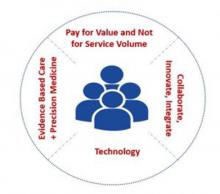

Ravi Raichur
The Path Forward: Creating a Value based Healthcare System
The healthcare industry is experiencing a tectonic shift in business, clinical, and operating models. Thus, change has become the new normal for healthcare industry. To deliver measurable, continuous value and enhance patient outcomes, the healthcare stakeholders viz., providers, payers, life sciences companies, and government bodies work collaboratively and constantly innovate to deliver affordable, equitable and accountable care.
In this regard, Value-based care (VBC) has emerged as a solution to address skyrocketing healthcare costs, reduce inefficiencies and improve access. In value-based care delivery, individual physician practices and hospitals are incentivised for improving the health of a specific population with chronic conditions in an evidence-based, cost-effective manner.
The crux of the value based care model is “improving quality and safety for a population with a patient centric” approach. In a value based care delivery set up, various specialty and practice teams coordinate and collaborate with a single goal of delivering cost effective, best possible care leveraging digital tools, 360-degree view of accurate patient information, evidence based care, personalized and precision medicine models across the care continuum.

Figure 1: Value based care delivery model
Value Based Care – Drivers & Ecosystem
Value has a larger role to play in care delivery to a specific population. The value perceived here refers to Patient outcomes per dollar spent. There is a need to restructure, redefine care models while looking at various avenues to improve patient outcomes continuously. The transition from “Volume to Value” will require fundamental restructuring of health care delivery models. The market trends that are reshaping the care delivery include:
- Technology proliferation, Demanding aging population that usher a consumer revolution resulting in a “New Health Economy” – estimated at more than 2.8 trillion Dollar (as per PwC Health Research institute)
- Empowered patients are the new consumers who drive a “Uberization of Healthcare” – expect quick, accurate, cost-effective service and a seamless omnichannel experience across various channels viz., social, in-person, customer care, web/mobile
- Realigning and Rethinking care delivery at various interventions viz., (pre-care, point of care and post care) tapping into Big Data, Mobility and IoT
Many providers, payer organizations who were reluctant to adopt value-based payment models are now on board and are geared up to building a strong ecosystem comprising – population health management(PHM), payment and reimbursement, care planning, care coordination, patient engagement, risk segmentation areas. Providers are investing heavily to configure their value based care delivery models and building new capabilities around following areas to outperform their competition.
- Population Health Management involves data aggregation, analytics, intervention management and engagement, outcomes & measurement, analysis of cost drivers and opportunities across the care continuum. This involves analysis of patient data to derive meaningful, actionable insights by which the healthcare stakeholders improve clinical and financial outcomes
- Risk Segmentation and Classification involves in depth analysis of the various stages of disease/severity and identification of risks based on clinical and lifestyle factors
- Care Planning leveraging evidence-based protocols to develop new clinical pathways, utilizing multi-disciplinary teams across continuum of care
- Care Coordination to manage conditions, intervene, and reduce total cost and improve quality outcomes by organizing patient care activities to deliver safer and effective care
- Payment Models & Incentive Management across stakeholders to provide higher-quality and cost-efficient care based on outcomes/value to promote effective population health management
- Patient Engagement enabled higher quality, cost efficient, self-care approaches to manage conditions, interventions to drive and promote positive patient behaviour
- Performance Monitoring and metric measurement involves reporting and analytics tools to measure outcomes, identify opportunities, and improve patient experiences
The Bottom line: A value-based model is key to winning in the future health care marketplace
The US health care industry is embarking on a journey to transform financial and business models to support outcome/value-based care. There is a lot of excitement and equal reluctance from providers as this involves a radical shift in the operating model that addresses innovative care delivery mechanisms and styles by:
- Integrating multi-disciplinary and specialty hospital that analyse patient data to deliver best possible care
- Building futuristic disease management and clinical decision support systems across the care continuum
- Developing a patient centric approach where the information and interactions pertaining to a patient are analysed and a personalized care plan is made ready
- Driving connected healthcare approach leveraging digital health technology, wearable, social care apps and specialty delivery teams
- Forging partnerships and collaborating with healthcare stakeholders, physicians, patients, and their families
A VBC model is a sure shot success formula for healthcare stakeholders to realize an integrated, patient engagement strategy and build a platform that pays rich dividends, by enhancing the ability to deliver patient-centric care that promises AFFORDABILITY, ACCESSIBILITY, & QUALITY.
Related Insights


On-Device AI & Edge Computing in Mobile Apps for the Healthcare Industry




